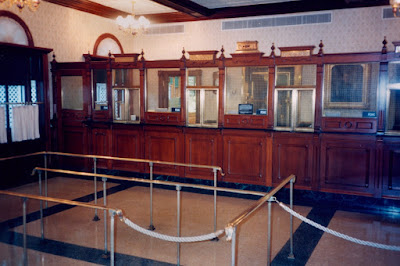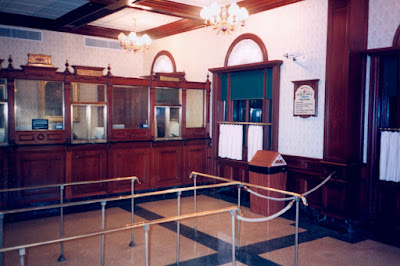Yogi Bear's Jellystone Park Campground, on Turkey Lake Road in southwest Orlando, opened in late 1969 and became Central Florida's first family-oriented attraction built around a famous character. It was the also the second Jellystone Park to exist anywhere, right after the original in Sturgeon Bay, Wisconsin opened that July. Its creator, Doug Haag, was reported to have considered different themes for his concept of a family campground chain and decided to pursue licensing for Yogi Bear through Hanna-Barbera upon seeing his kids watch Yogi on TV and hearing the name "Jellystone Park." He thought it would be a great fit for his aims.
The Orlando campground was along Interstate 4 between Orlando and Lake Buena Vista, accessed easiest by using the Sand Lake Road exit and driving down a then-very rural Turkey Lake* Road with cattle pastures, orange groves and an older (residential) trailer park being the other features. Big Sand Lake sat behind all of these things to the west. In the middle of the campground was Mirror Lake, which was renamed Boo Boo's Lake when the campground opened.
* Turkey Lake itself did not sit anywhere along Turkey Lake Road. Instead, it was located about a mile north of where Turkey Lake Road dead-ended at Conroy-Windermere Road.
"Yogi Bear Park," as my grandmother called it, was the first place I can remember that captured my heart and mind as a child. It was free to visit, and while it contained no rides or shows it featured enough Yogi-centric elements to make it feel special. And just as with Mr. Toad and Walt Disney World, it was this place that really introduced me to Yogi instead of cartoons on TV or theatrically released films. Seeing Yogi clinging to that tree at the base of the entrance sign with Ranger Smith shouting up at him, visiting the Ranger Station shop, playing Yogi Bear mini-golf and climbing into the 12' tall Yogi's picnic basket (or being held up to touch his necktie) were things that captivated me. I went to WDW at very young ages also, but my first memories of the Magic Kingdom were of being overwhelmed by just how much was going on and how big it was. Jellystone Park Campground was many things - overwhelming wasn't one of them.
Somewhere in the back of my head, as I grew to know more about Yogi Bear from his cartoons, View-Master reels and other toys, I kind of processed a disconnect between the heavily-forested topography of the animated Jellystone Park and this sunny, scrubby, palm tree-dotted Florida campground. The real-life version was cute, but didn't quite round the corner into ownership of its theme. But people did have mobile home ownership there. Retirees and whole families lived there year-round. The campground was even on my school bus route from Lake Bryan to Tangelo Park in the mid-1970s and I thought the kids who got on and off the bus at Jellystone Park were the luckiest kids on the planet. I'm currently not sure that they weren't.
Even though it didn't really look like a mountainous national forest, Orlando's Jellystone Park had some street names that evoked its source material. Those names included Avalanche Avenue, Boo Boo's Bluff, Bottomless Pit Place, Cindy Street, Geyser Gap and Yogi Pass. There was some alpine trim work on some of the buildings and just a few fake rocks found scattered around the property.
Over time, this particular Jellystone Park came to be in a state of disrepair. As a franchise owned by the family of its last manager Chris Peterson, much of the campground needed more themed component / landscape maintenance than it was given. This lent it the appearance of being a mobile home park built on the remnants of something more charming and fun. What the owners' obligation was to the parent company, I have no idea. It was sad, though, to visit it as an adult and see things I remembered fondly from childhood faded, falling apart, missing or covered in weeds.
The Petersons sold the campground to a developer in 1996 and everyone living on the property was given a couple months to relocate. After the campground was vacated, the new owner filled in part of Boo Boo's Lake and built The Jefferson apartments near Big Sand Lake, with the rest of the campground cleared and left mostly open.
Jellystone Park campgrounds (including the one built along Interstate 192 in Kissimmee in the early 1970s) no longer operate in Florida, but are thriving in other parts of the United States. The franchise was still expanding as of 2022. The last one I visited was in Cave City, Kentucky around 2018. It was well-maintained and pretty busy. I wanted to stay there but was outvoted on that point.
Some of the pictures below were from the collection of Disney animator Mark Kausler, posted on the blog of Doug Yowp. I don't like to use a lot of content from single, unofficial sources other than my own, but these photos were too good not to share with anyone who loves the topic.
 |
One of my later visits to the Orlando Jellystone Park
Campground in 1992. I could still fit in Yogi's basket!
Image source: Widen Your World, photo likely taken
by Dave Ensign |
 |
The entrance to the campground in 1995, one year before it closed. Image source: Widen Your World |
 |
| 1974 postcard |
 |
Entrance characters Yogi Bear & Ranger Smith, 1989 Image source: Mark Kausler via Doug Yowp |
%20rev.jpg) |
1973 bumper sticker Image source: Ebay |
 |
Cindy Bear on the mini-golf course, 1989 Image source: Mark Kausler via Doug Yowp |
 |
Campground postcard shot c. 1980. Some of these kids definitely
lived at the campground. Extra points for the Black Hole shirt. |
 |
Yogi Bear on the mini-golf course, 1989
Image souce: Mark Kousler via Doug Yowp |
 |
Yogi, Boo Boo and the Ranger on the Ranger Station's Roof, 1989
Image source: Mark Kousler via Doug Yowp |
 |
1970 brochure showing the campground as it appeared in its
brand-new state, including a fully-functioning Old Faceful geyser! |

%20rev.jpg)













.jpg)



















%20rev.jpg)


















